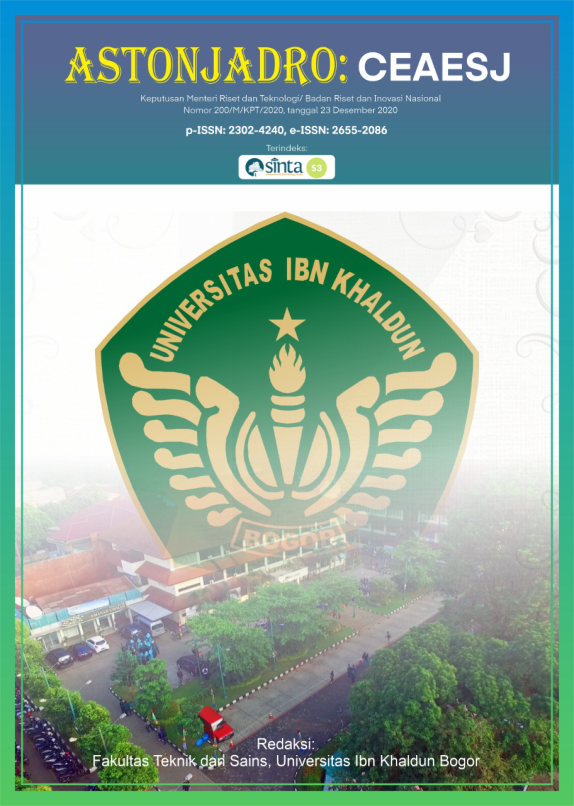EFFECT OF CHICKEN FEATHER WASTE ON CONCRETE MIXING ON COMPRESSIVE STRENGTH AND FLEXURAL STRENGTH
DOI:
https://doi.org/10.32832/astonjadro.v10i1.4330Keywords:
concrete fibers, waste chicken feathers, compressive strength, flexural strength.Abstract
The materials that are often used in the world of construction both in bridges, water structures, and buildings is concrete. The characteristic of concrete is that it is strong withstand compressive forces, but weak in resisting tensile forces. Therefore, it is necessary to improve the characteristics of the concrete. Improving the characteristics of the concrete can be done by applying a fiber mixture to the concrete. There are two types of fibers used as a concrete mixture, namely synthetic fibers and natural fibers. The research conducted was concrete using chicken feather waste fiber which was categorized as natural fiber with a fiber length of 3 cm, the grade of the concrete used was 20 MPa and the percentage of additional chicken feather waste was 0%, 1%, and 2% of the volume of concrete. The test is the compressive strength and flexural strength of the concrete using a specimen cylinder 15x30 cm and beam 15x15x60 cm. Each percentage of chicken feather waste that is used as a concrete mixture is 5 samples. From the test results, it was found that the concrete with the addition of 0% chicken feathers obtained an average compressive strength value of 200.78 kg/cm2, concrete with the addition of 1% chicken feather fiber, the compressive strength value increased to 215.09 kg/cm2 and concrete with the addition of chicken feather fiber 2 % has a compressive strength value of 197.54 kg/cm2. Meanwhile, the flexural strength values obtained were 24.00 kg/cm2, 23.03 kg/cm2, 21.08 kg/cm2 for the percentage of 0%, 1% and 2% fibers, respectively. This shows that the concrete with the addition of bristle fibers the chicken has decreased the compressive strength value when it has reached its optimum level. While the addition of the percentage of chicken feathers to the flexural strength value does not have much effect on the flexural strength of the concrete which tends to decrease. This is influenced by the characteristics of the chicken feathers which are difficult to bond with the concrete as well as being easy to absorb water, so that the concrete takes a longer time to dry after the maintenance of the concrete.
References
Amri, S. 2005. Teknologi Beton A-Z, Yayasan John Hi-Tech Idetama. Jakarta. (Indonesian).
Antoni and Nugraha, P. 2007. Teknologi Beton, Andi. Yogyakarta. (Indonesian).
Antonius, Darmayadi, D., Asfari, G. D. 2012. Perilaku Mekanik Beton Berserat Baja pada Suhu Tinggi, Laporan Penelitian Hibah Bersaing Perguruan Tinggi Tahun Anggaran 2012, Kementerian Pendidikan dan Kebudayaan. (Indonesian). http://research.unissula.ac.id/pages/penelitian.php?id=MzAxYXBheWFlbmtyaXBzaW55YT8=
Antonius, Widhianto, A., Darmayadi, D., Asfari, G. D. 2014. Fire Resistance of Normal and High-Strength Concrete with Contains of Steel Fibre. Asian Journal of Civil Engineering (BHRC), 15(5) pp.655-669. https://www.sid.ir/en/journal/ViewPaper.aspx?ID=419520
BSN. 2011. SNI 03-1974-2011: Cara Uji Kuat Tekan Beton dengan Benda Uji Silinder, BSN, Jakarta. (Indonesian).
BSN. 2011. SNI 03-4431-2011: Cara Uji Kuat Lentur Beton Normal Dua Titik Pembebanan, BSN, Jakarta. (Indonesian).
Chayati, N. and Widodo, S. 2016. Aplikasi Beton Bottom Ash untuk Pondasi Jalan. ASTONJADRO: Jurnal Rekaya Sipil, 5(1), pp.36-45. (Indonesian). http://ejournal.uika-bogor.ac.id/index.php/ASTONJADRO/article/view/833
Daniel, J. I., Gopalaratnam, V. S., Galinat. M. A. 2002. State of The Art Report on Fiber Reinforced Concrete by ACI Committee, USA, pp.544.IR-1-544.IR.2.
Elhusna, Supriani, F., Gunawan, A., Islam, M. 2011. Pengaruh Serat Sabut Kelapa Terhadap Kuat Lentur Beton dengan Faktor Air Semen 0,5. Inersia Jurnal Teknik Sipil, 3(1), pp.17-23. (Indonesian). https://ejournal.unib.ac.id/index.php/inersiajurnal/article/view/6706
Fajar Rizki Putranto, Syaiful Syaiful, 2019. PENGARUH PENAMBAHAN GENTENG PRESS JATIWANGI DAN DAMDEX TERHADAP KUAT TEKAN BETON, Jurnal Komposit, 3(1), pp.13-18. (Indonesian). http://ejournal.uika-bogor.ac.id/index.php/komposit/article/view/3742/2089
Handani, S. and Efilusi, D. 2011. Studi Pengaruh Penambahan Serat Terhadap Kuat Tekan dan Kuat Lentur Atap Serat Bulu Ayam. Jurnal Ilmu Fisika, 3(2), pp.75-79. (Indonesian). http://jif.fmipa.unand.ac.id/index.php/jif/article/view/64
Marwahyudi Marwahyudi, 2020. STIFFNESS DINDING BATU BATA MENINGKATKAN KEKUATAN STRUKTUR, ASTONJADRO: JURNAL REKAYASA SIPIL 9 (1),pp.30-37. (Indonesian). http://ejournal.uika-bogor.ac.id/index.php/ASTONJADRO/article/view/2840
Mastali, M., Naghibdehi, M. G., Naghipour, M., Rabiee, S.M. 2015. Experimental Assessment of Functionally Graded Reinforced Concrete (FGRC) Slabs Under Drop Weight and Projectile Impacts. Construction and Building Materials, 95 pp.296-311. https://www.sciencedirect.com/science/article/abs/pii/S0950061815301768?via%3Dihub
M Mubarak, R Rulhendri, S Syaiful, 2020. PERENCANAAN PENINGKATAN PERKERASAN JALAN BETON PADA RUAS JALAN BABAKAN TENGAH KABUPATEN BOGOR, ASTONJADRO: JURNAL REKAYASA SIPIL 9 (1), 1-13. (Indonesian). http://ejournal.uika-bogor.ac.id/index.php/ASTONJADRO/article/view/2694
Mulia, D.S., Yuliningsih, R. T., Maryanto, H., Purbomartono, C. 2016. Pemanfaatan Limbah Bulu Ayam Menjadi Bahan Pakan Ikan dengan Fermentasi Bacillus Subtilis. Jurnal Manusia dan Lingkungan, 23(1) No. 1, pp.49-57. (Indonesian). https://jurnal.ugm.ac.id/JML/article/view/18773
Mulyono, T. 2005. Teknologi Beton, Andi Offset. Yogyakarta. (Indonesian).
Putri, H. A. K. and Wardhono, A. 2017. Penggunaan Bulu Ayam Horn Sebagai Bahan Pengganti Serat Fiber Pada Campuran GRC (Glassfibre Reinforced Cement) Panel Dinding terhadap Kemampuan Uji Mekanis. Rekayasa Teknik Sipil 3(3), pp. 231-237. (Indonesian). https://ejournal.unesa.ac.id/index.php/rekayasa-teknik-sipil/article/view/21326
Rulhendri, Chayati, N., Syaiful. 2013. Kajian Tentang Penambahan Serat Terhadap Kuat Tekan Beton. ASTONJADRO: Jurnal Rekaya Sipil, 2(2), pp.44-48. (Indonesian). http://ejournal.uika-bogor.ac.id/index.php/ASTONJADRO/article/view/797
S Syaiful, 2020. ANALYSIS ON THE ADDITION OF FIBER THE STRONG BENDING MIXED CONCRETE, ARPN Journal of Engineering and Applied Sciences 15 (6), 724-729. http://www.arpnjournals.org/jeas/research_papers/rp_2020/jeas_0320_8152.pdf
Tjokrodimulyo, K. 2007. Teknologi Beton. Nafiri, Yogyakarta. (Indonesian).
Downloads
Published
How to Cite
Issue
Section
License
Paper submitted to ASTONJADRO is the sole property of the Astonjadro Journal. Unless the author withdraws the paper because he does not want to be published in this journal. The publication rights are in the journal Astonjadro.ASTONJADRO
LICENSE
This work is licensed under a Creative Commons Attribution-ShareAlike 4.0 International License.
Based on a work at http://ejournal.uika-bogor.ac.id/index.php/ASTONJADRO













